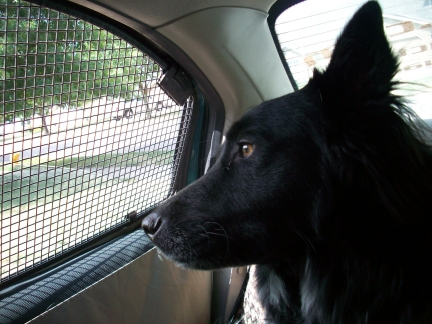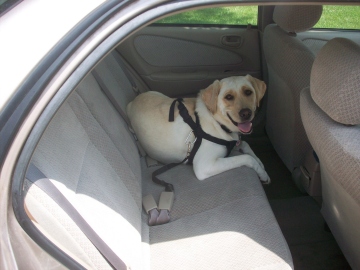Note: Dawn Ross of the Pet Auto Safety blog shares her tips on how to help a dog that doesn’t like riding in the car.
What is the typical image that comes to mind when you think of a dog in the car?
It’s the dog with his head out the window and a big, puppy grin on his face, right?
But for whatever reasons (bad experience, unfamiliarity, fearful tendencies, for example) some dogs really do not like riding in the car.
If you have such a dog, here are some things that can help.
How to train your dog to like riding in the car
The number one thing you can do to help a dog that is afraid of car rides is to introduce him to the car slowly and positively.
People don’t overcome their fears overnight, so don’t expect these training tips to “cure” your dog of his fear instantly either. The following steps will take time (days, weeks or longer), and it is even possible that your dog will never come to like riding in the car.
But in the long run, dog training methods using desensitization, counter conditioning, and positive reinforcement can go a long way to help reduce your dog’s anxiety.
1. Introduce your dog to the outside of the car.
Introduce your dog to the car from the outside, but don’t take him in the car. Walk around it, let your dog sniff it, and reward him with treats or his favorite toy. If you use clicker training, click and reward. If you use your voice, praise in an upbeat tone. Always keep your voice upbeat.
2. Sit in the car without the car running.
Once your dog is secure with step 1, sit in the car with him but don’t turn the car on. Get him to play if you can or just sit quietly and reward him with treats. Be careful about soothing (more on that below).
3. Sit in the car with the car running.
Make sure your dog is comfortable with step 1 and 2, then sit in the car with the car running but don’t go anywhere (make sure your car is outside and not in the garage in order to prevent carbon monoxide poisoning). If it is just you training your dog, sit at the wheel and have your dog sit where you are going to expect him to sit when you drive. Since you’re not driving, it is OK to distract your dog with treats or toys.
4. Take short drives.
Once it seems your dog has gotten used to being in your car when it’s running, take short drives around town. If possible, avoid too much turning as this can cause car sickness. Go to the drive-through at your bank or favorite fast food place. Visit a park or a pet store. Make sure your destination is not a place your dog hates, like the groomer or vet office. And make sure you never leave your dog alone in the car while you run errands.
5. Make your trips a bit longer.
At this point, you can start to make the road trips longer and longer. Remember, the more frequently you do these steps, the better. For example, do step 1 three times a day every day for weeks, if needed, before moving onto the next step. Once you get to step 4, try to do it once a day or a few times a week. The amount of time it takes for each step depends on your consistency and on your dog’s level of fear of car rides.
Other helpful tips to get a dog used to the car
Dog training is a long-term solution that can take even longer if you are not working at it regularly. Fortunately, there are a few supporting tips to help. Some of the following tips may do the trick to help your dog be less stressful on car rides, but most are simply supporting methods that work best in conjunction with dog training. They are:
1. A pet crate.
Some dogs feel more comfortable in a den-like enclosure. If your dog is already crate trained, using the familiarity of her own “den” can add to her comfort. Sometimes dogs don’t like to ride in the car because they keep sliding off the seat when you take a turn or stop. A pet travel crate can also help with this. Incidentally, so can a dog car seat belt. Learn more about these products here and here.
2. Familiar items.
Your dog will probably be much more comfortable in the car if there is something he is familiar with such as his own pet bed or a few toys.
3. Pet anxiety remedies.
There are a number of medications, dog appeasing pheromones (DAP), natural herbal remedies and anxiety wraps that claim to help dogs be calmer. Your vet may be able to provide a calming medication with L-Theanine, Benzodiazepines or other types of pet anxiety drugs.
For natural, herbal essential oils and aromatherapy, look for ingredients like chamomile, rockrose, lavender, valerian root or bergamot. Two great examples of natural pet anxiety remedies include Rescue Remedy and one specifically for dogs with anxiety about car rides – Travel Calm. Anxiety wraps include the Thundershirt, Rein Coat and others.
4. Windows down.
A fresh breeze in the car can help to reduce the anxiety of some dogs when they ride in the car, so roll down a window. Also, some dogs don’t like riding in the car because they get car sick. Making sure they can see out the window can help to alleviate car sickness. If you have a small dog, consider a dog car booster seat.
5. Soothing music.
Music can do wonders for people, and believe it or not it can do wonders for a dog too. Piano music has been shown to be soothing to dogs. In fact, Through a Dog’s Ear has a number of CDs to help dogs with anxieties and other issues.
6. Someone in the back seat.
Having someone your dog knows in the back seat can be very helpful to a dog that doesn’t like riding in the car. They can help calm the dog with a massage, t-touch techniques, or just to simply distract the dog with toys. Be careful about soothing the dog too much. It is suspected that soothing a dog confirms that the car is something to be afraid of. The person in the back of the car should make sure that their own emotions are calm and that they behave as naturally as possible so as not to give the wrong message.
Every dog is different, so some dogs may respond to training faster than others. And some dogs do very well with pet anxiety remedies while on others they don’t work at all. Find what works best for your dog, and then perhaps someday your dog will come to love riding in the car.
What has helped your dog learn to like (or put up with) the car?
Get That Mutt’s newsletter in your inbox:



Lois Erdmann
Thursday 20th of December 2018
I need to give some of these tactics a try. I keep hoping that my pup is less stressed going for road trips. So far it has been a pretty bumpy ride. It has not been easy for her from her first trip home in a small soft sided kennel. I know she would rather be held but I drive alone for the most part. I don't want to start that and worry it would interfere with driving. I gave up on the carrier and tried a puppy car seat that she can move around in next to me but still be secured inside. It is better but not a complete win. Toys are ignored and even chewies don't get a second glance. I have thundershirt from my last dog that I can try. I hope something helps her soon.
JoanD
Tuesday 25th of October 2016
Wow. Such positive results. I've only had 2 dogs. My first would just lay down & sleep. My 2nd I got around the same time I had surgery. He was 3 mos old before I was able to drive. At first he got car sick but that stopped when I withheld food. He is now three. He jumps right into the car withou any sign of anxiety UNTIL it begins to move. Then the whining starts. I've tried natural remedies, prescription meds, a travel kennel, the thunder shirt, blinders & a harness. Nothing stops the whining. I've settled with the harness to keep him in the back seat and a muzzle to reduce whining. If we get on the interstate he will go to sleep but as soon as I slow down for a turn or rest stop he gets vocal & restless. Any suggestions would be appreciated
Kelley
Saturday 2nd of August 2014
Jedi got car sick as a young puppy. Even now he gets anxious and starts smacking his lips like he's anticipating throwing up. Things I do that helps (a little): * If I know that we'll be travelling, I only give him 1/2 his breakfast * We don't travel within an hour of eating * I give him Bonine an hour before we leave We are taking smaller, fun trips, I roll down the window, and whenever possible, bring Roxy (my other dog who LOVES car rides). I think her joy distracts him and he forgets that he may get sick.
Lindsay Stordahl
Sunday 3rd of August 2014
Thank you. This will be helpful for others who are dealing with potentially car-sick pups.
Sarah at LolaThePitty.com
Saturday 2nd of August 2014
I'm so glad that Lola & Rio love car rides. But we had two shelties growing up, neither of which really enjoyed car rides. One of them would get sick and actually throw up where the other one would just become really anxious and stress himself out. Poor guys.
Lindsay Stordahl
Saturday 2nd of August 2014
Aww, poor guys. Glad Rio and Lola don't have any issues.
Ron Rutherford
Tuesday 29th of July 2014
My dog Leela has had some major anxiety and car sickness issues. I'm going to give these tips a try and see if they don't help her out. Thanks for the fantastic article!
Lindsay Stordahl
Tuesday 29th of July 2014
Dawn shared some great tips! Hopefully you see a difference soon with your dog.